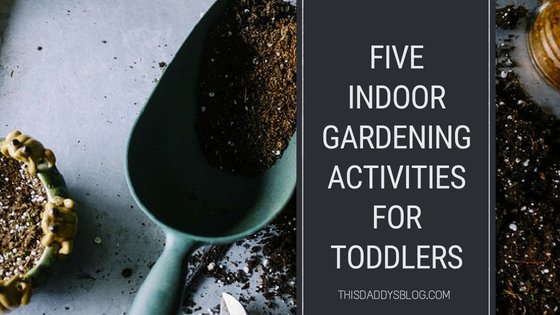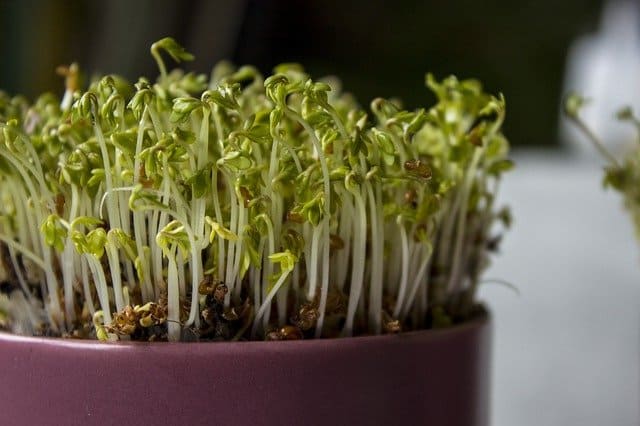
Sharing a meal with your family is a wonderful way to come together at least once a day. However, involving your toddlers in a bit of rainy or winter day indoor gardening is an ideal way to spend some quality time together and teach them about the food they eat.
As far back as I can remember, my parents have had a garden. Every spring they would till the soil, create their rows, and plant a variety of summer crops: beans, potatoes, lettuce, radish, carrots, onions, pumpkins, squash, zucchini, cucumber, tomatoes, and more. In the autumn, they would diligently harvest the fruits (vegetables) of their labor; can it, bottle it or store it in the root cellar; and all winter long we would enjoy the vegetables they grew. Even today, many years later, their summer garden is a sight to behold.

Sadly, I did not inherit the green thumb of either of my parents. I do, however, appreciate the flavors, freshness, and quality of home grown vegetables. There is nothing more satisfying than biting into a ripe tomato you grew yourself.
As a condo dweller, finding a place to plant a garden can be a bit of a challenge. But I was determined to give my children, if not the garden experience of my childhood, then at least an appreciation of what it takes to grow the food we eat and how it differs from what you can buy at a supermarket. I decided to create our own indoor garden using a couple of metal shelves and some LED grow lights for indoor plants I found online.
(NOTE: I turn the lights off when my kids are working around the lights just to avoid them staring directly at one of the lights for too long.)
To introduce gardening to children, here are five ways to get them involved and their hands a bit dirty, which they of course will stick in their mouth at some point; the hazards of playing in the dirt!
1. First, plant some seeds!
Planting seeds is an easy task that is very tactile. My kids love to touch things and watching them poke seeds into the soil is great fun. Initially, I suggest planting seeds for vegetables that grow quickly, such as lettuce, radishes, or green onions. It helps keep young, easily distracted minds focused when there is something to see as soon as possible. Also, don’t plant everything on the first day. Spread out the planting so there aren’t long gaps waiting for things to change.
For older children, maybe ask him or her to select a preferred vegetable and get them excited to grow their own. My oldest loves snap peas, so he’s planted a half dozen seeds and we’ll see how they do this year.

2. Keep track of the growing
Have the plants grown? Are they bigger? What has changed? Ask them to feel the soil: is it dry? Damp? Do the plants need water? What colors do they see? It’s a great way to develop your child’s vocabulary and senses. Keep a small log book of what’s happening with the vegetables and maybe ask your toddler to draw a picture or two, if they are so inclined.
3. Repotting as things grow
Have I mentioned how much my toddlers love to mess around in the dirt? Repotting was definitely a hit. I laid old newspaper down on our hardwood floor and brought in some potting soil. I demonstrated how to fill a new pot with the soil and off they went. It was kind of like watching them on a beach, only the sand was much browner.
Once the new pots were full, we worked together to transfer the seedlings to their new homes. Each plant got a name and both of my toddlers got a bath. It was great fun and there were lots of giggles as they dug around in the dirt.
4. Harvest your garden
The moment of truth: did anything grow? Of course! Maybe not as much as we hoped, but there will still be something. The first crop up for us was lettuce so we harvested some, snacking away pretending we were rabbits. We are still waiting on some of the bigger vegetables but they are coming along. I especially enjoy watching my oldest discover how things grow and change. Currently he’s fascinated by tomatoes (why are they green and not red, Daddy?) and beans; we have to check them every day now.

5. Make some seed storage bottles
Indoor gardens you can keep going all year long, so storing seeds isn’t as big of an issue. However, I’ve been working on seed storage bottles with my toddlers as gifts for their grandparents. It’s an interesting way for a child to share their gardening experience with their grandparents and tell a story. My parents are already planning to dedicate a small corner of their own garden for the kids to grow vegetables from their seed storage next year.
To store seeds they first need to be dried. After harvesting, spread the seeds you want to keep on a newspaper to dry for a week or so. Once they’ve dried, pack them in airtight containers and store in a cool, dry location. We are planning to store ours in mason jars and place them in our storage room in the parking garage.
I’ve enjoyed creating this gardening space for our family and sharing it with my kids. Maybe I don’t have a green thumb, but maybe one of them will develop one. If not, I hope they will at least learn the basics of how plants grow and have a bit of fun along the way!
Do you have any fun or engaging indoor gardening activities you enjoy with your toddler? Send me a message; I’d love to hear about it!